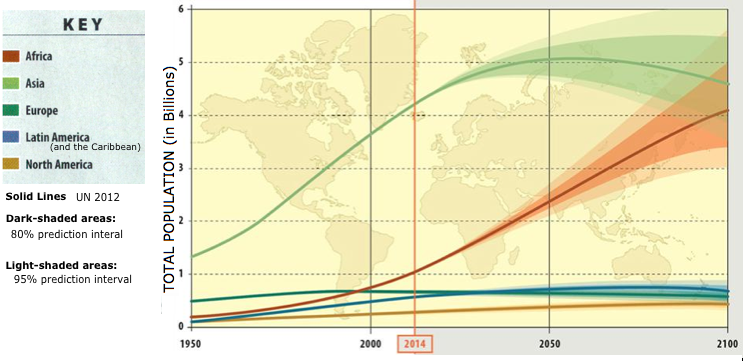 Places
Places
 Universe
Universe
 Solar System
Solar System
 World
World
Don's Home
 Places
Places
 Universe
Universe
 Solar System
Solar System
 World
World
| Contact |
World The earth's axis is tilted 23.4° relative to the plane of rotation around the sun (It varies from 21.5° to 24.5° with a 41,000 year periodicity.)
At the summer solstace (June 20 or 21st) the sun is directly overhead at the Tropic of Cancer and there is 24 hrs. of daylight inside the artic circle.
The earth's axis is tilted 23.4° relative to the plane of rotation around the sun (It varies from 21.5° to 24.5° with a 41,000 year periodicity.)
At the summer solstace (June 20 or 21st) the sun is directly overhead at the Tropic of Cancer and there is 24 hrs. of daylight inside the artic circle.The area bounded by the Tropic of Cancer on the north and Tropic of Capricorn on the south is known as the "tropics."
Regions - Population:
Source: 7 continents of the World | Worldometer United Nations 2006 population revision (Millions)
- Less developed regions: They comprise all regions of Africa, Asia (excluding Japan), Latin America and the Caribbean plus Melanesia, Micronesia and Polynesia (see definition of regions) Source: United Nations (POPULATION AGEING) More detail in Reference  How Much Will Each Continent's Population Grow Over the Next Century? | Sierra Club May/June 2015
How Much Will Each Continent's Population Grow Over the Next Century? | Sierra Club May/June 2015
| |||||||||||||||||||||||||||||||||||||||||||||||||||||||||||||||||||||||||||||||||||||||||||||||||||||||||||||||||||||
Oceans:Name Size % of earth Pacific 69,375,000 sq mi 35% Atlantic 41,105,000 sq mi 21% North Atlantic Indian 28,900,000 sq mi 15% Arctic 14,056,000 sq mi 7% Antarctic or Southern All 141,600,000 sq mi 72% See: Oceanography The Earth's OceansCountries & Territories (Country Codes - Tel., web) Largest populations Popular World Cities, Sites Vacation & Recreation Destinations. Maps: U. Texas, CIA - The World Factbook (Political Map (pdf)) Lonley Planet, National Geographic
Travel Information: |
Other Information: CIA CIA - The World Factbook 1clic1planet.com US State Department: Regions, Travel Warnings, Per Diems Other: Demographics (population, ..) Longitude and Latitude See Sunrise - Sunset in Astronomy. |
||||||||||||||||||||||||||||||||||||||||||||||||||||||||||||||||||||||||||||||||||||||||||||||||||||||||||||||||||||
|
World Tourism Organization (WTO) Statistics Popular World Cities Popular World Sites World Crime Rates Languages Countryrisk.com | the country analysis resource Links: World Top Ten Maps Return to Places | |||||||||||||||||||||||||||||||||||||||||||||||||||||||||||||||||||||||||||||||||||||||||||||||||||||||||||||||||||||